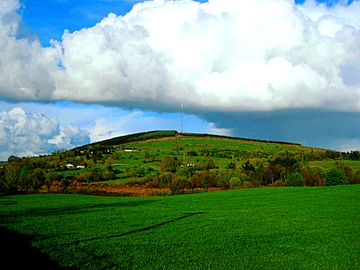Carn Clonhugh facts for kids
Quick facts for kids Carn Clonhugh |
|
|---|---|
| Carn Clainne Aodha (Irish) | |

Cairn Hill
|
|
| Highest point | |
| Elevation | 278 m (912 ft) |
| Prominence | 200 m (660 ft) |
| Listing | County Top (Longford), Marilyn |
| Geography | |
| Location | Killoe, County Longford, Republic of Ireland |
| Parent range | Longford Hills |
| OSI/OSNI grid | N187840 |
Carn Clonhugh, also known as Corn Hill or Cairn Hill, is the highest point in County Longford, Republic of Ireland. It stands 278 meters (about 912 feet) above sea level. You can find it north of Longford town, between the villages of Drumlish and Ballinalee. On top of the hill, there is a tall television mast, which adds another 123 meters (about 404 feet) to its height.
Contents
What's in a Name? The Story of Carn Clonhugh
The name Carn Clonhugh comes from the Irish words Carn Clainne Aodha. This means "cairn of Clann Aodha." A cairn is a pile of stones, often used as a monument or burial place. "Clann Aodha" was an old territory in the northwest part of County Longford.
The first time this hill was shown on a map was in 1837. Back then, it was called Carn Clonhugh. Later, around 1887, maps started calling it Corn Hill. This name, "Corn," is a simpler way of saying "Cairn." Today, many local people still call it Corn Hill.
Sliabh Carbry: An Older Name
Long ago, this hill was also known as Sliabh Carbry. This name came from an ancient kingdom called Cairpre Gabra. Some old writings even suggest an even older name, Sliabh Uillinn. One old story says Sliabh Carbry was the "mountains of Uillim red-edged, the son of Fionn."
What is Carn Clonhugh Made Of?
Carn Clonhugh is in an area of north Longford that has many rocks from the Middle to Upper Ordovician period. These rocks include slate, sandstone, and a type of rock called greywacke. This information comes from the Geological Survey of Ireland.
Amazing Views from the Top
From the top of Carn Clonhugh, you can see far and wide across the landscape. While some trees might block parts of the view from one side (Cairn A), another spot called Cairn B offers a fantastic panorama. From Cairn B, you can see from the west-southwest all the way to the south-southeast. You can clearly spot Slieve Bawn and the power station at Lanesborough–Ballyleague. You can also see Ardagh Hill.
Ancient Secrets: Archaeology on the Hill
Carn Clonhugh is very important because it has two possible ancient burial sites on its top. These are thought to be passage graves. Passage graves are very old tombs, usually made of stone. They often have a long passage leading to a central room. The roof of this room might be shaped like a dome. The edge of the tomb would often have large stones called kerbstones, similar to those at famous sites like Newgrange in County Meath.
Passage tombs are often built in special, high places like hilltops. The simpler a passage tomb is, the older it usually is. The possible passage tombs on Carn Clonhugh are believed to be among the oldest in Ireland.
The largest of these sites is called Cairn A, or Carn Caille. It marks the very highest point of the hill. This cairn is about 18 meters (about 59 feet) wide and 3 meters (about 10 feet) high. People didn't talk much about this cairn until 1960. That's when the Ordnance Survey Ireland put a special measuring station there. Before they built it, they dug up part of the cairn. They found cremated bones inside a rectangular room in the center. Today, we have GPS technology, so this old measuring station is no longer needed.
The second site, Cairn B, is about 50 meters (about 164 feet) north of Cairn A. It is about 9 meters (about 30 feet) wide. It's harder to see because it's covered by peat and heather.
Legends and Stories: Folklore of Carn Clonhugh
Cairn A (Carn Caille) has two interesting legends connected to it.
One story says that this is where Furbaide Ferbend is buried. Furbaide was the nephew of the famous Queen Maeve and was said to be her killer. An old name for one of the cairns on Sliabh Carbry was indeed "Carn Furbaidhe."
The second legend tells us that Cairn A was created by the Cailleach a Bheara. She was an ancient hag or witch. The story says she dropped stones from her apron as she flew over the hill, creating the cairn. This same legend is told about many other passage grave sites across Ireland, like Carrowmore and Carrowkeel Megalithic Cemetery in County Sligo.
Images for kids
See also
 In Spanish: Carn Clainne Aodha para niños
In Spanish: Carn Clainne Aodha para niños











